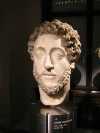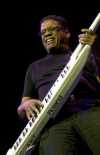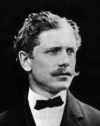This fresco, painted sometime between 1304 and 1306, features an accurately represents a comet above the Nativity stable. The fresco's realistic potrayal strongly suggests that it was based on the artist's first-hand observation of the comet Halley during its appearance in the skies over Europe in Oct. 1301. Almost seven centuries later the spaceprobe "Giotto" from the European Space Agency, was designed to study Halley's Comet. On March, 13, 1986, Giotto approached at a 596 kilometer distance from Halley's nucleus and obtained our first direct images of a comet nucleus. Giotto's images showed the nucleus to be an irregular object, something like a potato, with dimensions 15 km long and up to 10 km wide (picture).
Saturday, 30 December 2006
Giotto and the comet
This fresco, painted sometime between 1304 and 1306, features an accurately represents a comet above the Nativity stable. The fresco's realistic potrayal strongly suggests that it was based on the artist's first-hand observation of the comet Halley during its appearance in the skies over Europe in Oct. 1301. Almost seven centuries later the spaceprobe "Giotto" from the European Space Agency, was designed to study Halley's Comet. On March, 13, 1986, Giotto approached at a 596 kilometer distance from Halley's nucleus and obtained our first direct images of a comet nucleus. Giotto's images showed the nucleus to be an irregular object, something like a potato, with dimensions 15 km long and up to 10 km wide (picture).
Subscribe to:
Post Comments (Atom)
Contents of the day
Article of the Day
  CommodusThe son of Marcus Aurelius, Lucius Aurelius Commodus Antoninus was a Roman emperor who ruled from 180 to 192 CE—a period some historians view as the beginning of the empire's decline. Though his reign was relatively peaceful, Commodus was a tyrant who spent lavishly on gladiatorial combats, persecuted the Senate, and even renamed Rome after himself. He fancied himself a gladiator, frequently battling both men and animals, and considered himself the reincarnation of what mythical hero? More... Discuss |
Article of the Day
provided by The Free Dictionary
This Day in History
 Liberian President William R. Tolbert Is Killed in Military Coup (1980)Liberia was founded in the 1820s by former slaves from the US, and tensions between the Americo-Liberian minority and the indigenous majority have persisted since that time. On April 12, 1980, a group of soldiers led by Samuel Kanyon Doe stormed the executive mansion, killing Americo-Liberian President William R. Tolbert and 27 other government leaders. Doe, a member of the ethnic Krahn tribe, then declared himself president. How had a rice scandal seriously undermined Tolbert? More... Discuss |
This Day in History
provided by The Free Dictionary
Today's Birthday
  Herbert Jeffrey "Herbie" Hancock (1940)Hancock is a jazz and funk pianist, composer, and bandleader who emerged as part of Miles Davis's group in the mid-1960s. An early adopter of electronic instruments, he became involved with funk and disco in the 70s, while continuing to tour with jazz groups, such as that of Wynton Marsalis. He won an Academy Award for his original score of the 1986 film 'Round Midnight and has won 14 Grammys, including "Album of the Year" for a work that paid tribute to what fellow musician? More... Discuss |
Today's Birthday
provided by The Free Dictionary
In the News
snigger discuss | |
| Definition: | (verb) Laugh quietly. |
| Synonyms: | snicker |
| Usage: | The rude tourists snigger at the locals' outdated ways and dress. |
In the News
provided by The Free Dictionary
Quote of the Day
  Clock, n.: A machine of great moral value to man, allaying his concern for the future by reminding him what a lot of time remains to him. Clock, n.: A machine of great moral value to man, allaying his concern for the future by reminding him what a lot of time remains to him.Ambrose Bierce (1842-1914) Discuss |
Quote of the Day
provided by The Free Library
No comments:
Post a Comment